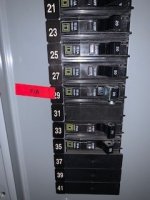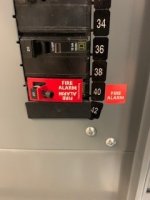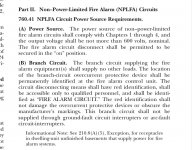You are using an out of date browser. It may not display this or other websites correctly.
You should upgrade or use an alternative browser.
You should upgrade or use an alternative browser.
Fire alarm circuit 760.41(b)
- Thread starter Hv&Lv
- Start date
- Status
- Not open for further replies.
That’s second one is what I’m getting hit for…Here are two instances of it at this site:
View attachment 2558585
View attachment 2558586
Based on the wording of that section, the second instance clearly fails since not a word of the manufacturer's markings is visible. Not sure why they'd even sell something like that... Anyways, I'll need to fix that.
I’ll try the red sticker. It’s cheaper anyway.
- Location
- New Jersey
- Occupation
- Journeyman Electrician (retired)
Can't you just remove the lockon kit to read it? It's still accessible the way that it is.
gadfly56
Senior Member
- Location
- New Jersey
- Occupation
- Professional Engineer, Fire & Life Safety
If they had added the word "permanently" before "obscure", you'd have a case. Sounds like a proposal for the next code cycle.Can't you just remove the lockon kit to read it? It's still accessible the way that it is.
- Location
- Illinois
- Occupation
- retired electrician
It is pretty unlikely that you are working with a fire alarm system that is covered by that section. Much more likely that 760.121(B) applies, but there is little difference.I wish…
“not damage…or obscure the manufacturer’s markings.”
Technically he is right since obscure means to hide or keep from being seen…
But still, c’mon man!
View attachment 2558592
Note that NFPA 72, and not the NEC, has purview over these requirements.
10.6.5.1.2* The branch circuit supplying the equipment shall supply no other loads.
10.6.5.2 Circuit Identification and Accessibility.
10.6.5.2.1 The location of the branch circuit disconnecting means shall be permanently identified at the control unit.
10.6.5.2.2* The system circuit disconnecting means shall be marked to identify the system or equipment that it serves.
10.6.5.2.3 For fire alarm and/or signaling systems, the circuit disconnecting means shall have a red marking.
10.6.5.2.4 The red marking shall not damage the overcurrent protective devices or obscure the manufacturer’s markings.
10.6.5.2.5 The circuit disconnecting means shall be accessible only to authorized personnel.
10.6.5.3 Mechanical Protection.
The branch circuit(s) and connections shall be protected against physical damage.
10.6.5.4 Circuit Breaker Lock.
Where a circuit breaker is the disconnecting means, an approved breaker locking device shall be installed.
10.6.5.5 Overcurrent Protection.
An overcurrent protective device shall be provided in accordance with NFPA 70.
Only the red marking is prohibited from obscuring the breaker markings....the red lock-on device is not prohibited from doing that. As long as there is a red marking that does not obscure the breaker markings you are good to go.
I’m just going by the letter..It is pretty unlikely that you are working with a fire alarm system that is covered by that section. Much more likely that 760.121(B) applies, but there is little difference.
Note that NFPA 72, and not the NEC, has purview over these requirements.
Only the red marking is prohibited from obscuring the breaker markings....the red lock-on device is not prohibited from doing that. As long as there is a red marking that does not obscure the breaker markings you are good to go.
1.
Verify the electrical breaker for the fire alarm control panel is marked red. [2013 NFPA 72 12.2.4.3
and 2017 NPFA 70 760.41(B)7
The project cannot be approved until we receive acceptable
I can understand why you would want to prevent someone from turning off the fire alarm circuit. But wouldn't the second device (in picture above) prevent it from opening in a ground fault situation? If that's the case, why even have over current protection? Second question, if this is for non power, only fire alarm, do you really need a 20 amp breaker? I'm new, please don't bite my head off if these are dumb questions.
- Location
- New Jersey
- Occupation
- Journeyman Electrician (retired)
There are no dumb questions, a circuit breaker will trip even if locked in the closed or ON position.I can understand why you would want to prevent someone from turning off the fire alarm circuit. But wouldn't the second device (in picture above) prevent it from opening in a ground fault situation? If that's the case, why even have over current protection? Second question, if this is for non power, only fire alarm, do you really need a 20 amp breaker? I'm new, please don't bite my head off if these are dumb questions.
- Location
- Illinois
- Occupation
- retired electrician
I just have not seen a new fire alarm panel that is covered by 760.41 in the last 30+ years.I’m just going by the letter..
1.
Verify the electrical breaker for the fire alarm control panel is marked red. [2013 NFPA 72 12.2.4.3
and 2017 NPFA 70 760.41(B)7
The project cannot be approved until we receive acceptable
electrofelon
Senior Member
- Location
- Cherry Valley NY, Seattle, WA
- Occupation
- Electrician
Interesting....."the branch circuit shall not be supplied through AFCI or GFCI".....what about the " if the GFCI/AFCI trips there is something wrong with the circuit" argument?I wish…
“not damage…or obscure the manufacturer’s markings.”
Technically he is right since obscure means to hide or keep from being seen…
But still, c’mon man!
View attachment 2558592
well, I guess if there’s a fire, don’t trip for any reason…Interesting....."the branch circuit shall not be supplied through AFCI or GFCI".....what about the " if the GFCI/AFCI trips there is something wrong with the circuit" argument?
electrofelon
Senior Member
- Location
- Cherry Valley NY, Seattle, WA
- Occupation
- Electrician
In America, shouldn't I have the freedom do decide that the meat in my chest freezer is subject to the same criteria?well, I guess if there’s a fire, don’t trip for any reason…
Agree wholeheartedly..In America, shouldn't I have the freedom do decide that the meat in my chest freezer is subject to the same criteria?
My refrigerator in the kitchen is not afci or GFCI,
Nor are the refrigerator or freezer in the garage.
There’s a half a cow in the freezer. Don’t want a garage GFCI to trip during a lightning storm and ruin the contents.
I agree with don I think they cited the wrong code unless your updating a building keeping a old 120V simplex system?
I would ask them if they meant to cite 760.124
I would be interested to see a new fire alarm circuit that is non-power limited.
I would ask them if they meant to cite 760.124
I would be interested to see a new fire alarm circuit that is non-power limited.
ramsy
NoFixNoPay Electric
- Location
- LA basin, CA
- Occupation
- Service Electrician 2020 NEC
I just have not seen a new fire alarm panel that is covered by 760.41 in the last 30+ years.
760.41 should apply to hard-wired smoke detectors in most dwelling, supplied by building line voltages, as clarified by OCP requirements in 760.43.
- Location
- Illinois
- Occupation
- retired electrician
Nothing in Article 760 applies to hard wired smoke alarms in a dwelling. Article 760 only applies if you have a fire alarm control panel.760.41 should apply to hard-wired smoke detectors in most dwelling, supplied by building line voltages, as clarified by OCP requirements in 760.43.
That seems really strict, especially when you can still see the trip rating, and there are multiple other breakers in the same panel with the exact same markings.How are you guys addressing this?
Do the red fire alarm lockout kits “obscure the manufacturers markings”?
- Status
- Not open for further replies.




